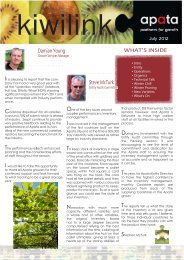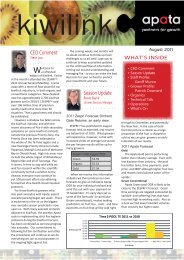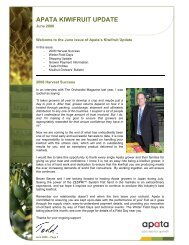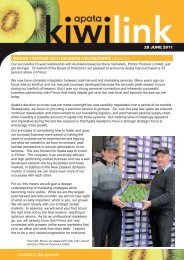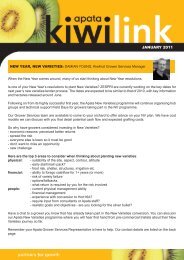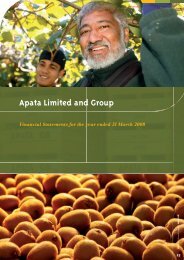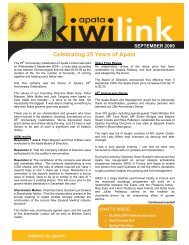Create successful ePaper yourself
Turn your PDF publications into a flip-book with our unique Google optimized e-Paper software.
<strong>kiwilink</strong><br />
MD Comment<br />
Dave Goodwin<br />
Managing Director<br />
Thirty years ago the kiwifruit harvest would kick<br />
off on the 1st May with a shot-gun start across the<br />
whole industry. Harvest planning was easy because<br />
everyone knew when the season was going to start<br />
and for growers, the harvest was a celebration of the<br />
completion of another growing season.<br />
Then in the early 80’s the 6.2 brix maturity criteria<br />
was introduced for Hayward kiwifruit with the start of<br />
harvest moving to late April, and uncertainty around<br />
start dates became the new reality. Then, due to<br />
market demand for even earlier fruit supply, KiwiStart<br />
maturity criteria were introduced which allowed some<br />
fruit to be harvested even earlier.<br />
ZESPRI Gold was commercialised over ten years<br />
ago with the young plants providing early maturing<br />
fruit which met eager market demand from late<br />
march.<br />
But as those vines got older the fruit maturity was<br />
delayed, but not the market demand. The emphasis<br />
change to locating regions with naturally early<br />
maturing fruit to provide fruit for early market supply.<br />
Nowadays with supply Caps, Protocols, Gold<br />
fractiles, Green fractiles, Brix fractiles and a range<br />
of other criteria to determine if fruit can be cleared<br />
for harvest, the start of harvest is anything but a<br />
celebration. Nevertheless, we look forward to the 2012<br />
season getting underway this week.<br />
I wish all growers a successful harvest, and our<br />
thoughts are with those amongst us who do not have<br />
fruit due to the devastating impact of Psa.<br />
Grower Meeting<br />
March 2012<br />
What’s inside<br />
On behalf of the <strong>Apata</strong> Directors, I would like<br />
to invite all our kiwifruit growers to a grower<br />
meeting. The Board are committed to keeping<br />
growers informed on developments at <strong>Apata</strong><br />
and are kicking it off with an update on harvest<br />
and operational planning for 2012, including Psa<br />
management processes. This is a chance for you<br />
to come and meet the Directors and myself.<br />
The meeting will be held on Tuesday 3 April from<br />
3.30pm in the Kaimai shed lunchroom at the<br />
Turntable Road site from 3.30pm.<br />
See you there.<br />
Regards<br />
Dave<br />
• MD Comment<br />
• PSA<br />
• PSA Reminder<br />
• Technical Talk<br />
• Pre Season<br />
• Contact Details<br />
• What’s On
PSA<br />
Damian Young<br />
Kiwifruit Grower<br />
Services Manager<br />
Psa Recovery Pathway<br />
The harvest season is upon us. With the first Gold<br />
fruit for <strong>Apata</strong> coming out of the Athenree/<br />
Waihi area, the drymatters are looking good on<br />
both varieties and tracking well above last year.<br />
The first green orchards are going up for maturity<br />
clearances at the end of the week with early<br />
indications that we may be in for a small fruit year.<br />
Before we get busy with the rush of harvest it<br />
would pay to take some time and reflect on your<br />
plans for your orchard. Psa has bought a new<br />
complexity to the decision making process. A balance<br />
between survival and risk mitigation has seen orchard<br />
management change forever, however there is some<br />
optimism with the confirmation of the recovery pathway.<br />
Following an extensive round of industry consultation,<br />
ZESPRI has confirmed the start of a recovery pathway<br />
from Psa involving the wide-scale release of Gold3.<br />
ReleaseMechanism Price<br />
(inclGST)<br />
Hort16A/Gold9(PsaV<br />
affected)VarietyLicence<br />
Transfer<br />
(Transfertoeither:Gold3or<br />
Green14)<br />
AdditionalGold3Licence<br />
- FixedPriceBid<br />
allocation(non<br />
Hort16A)<br />
- ClosedCommercial<br />
Tender<br />
<br />
Green14<br />
- FixedPriceBid<br />
<br />
Gold9<br />
- FixedPriceBid<br />
$8k:Gold3<br />
$3k:<br />
Green14<br />
<br />
<br />
<br />
$8k<br />
<br />
Tender<br />
<strong>Apata</strong> is here to help it growers with<br />
technical and practical advice on matters of<br />
orchard conversion and the growing of the newly<br />
commercial varieties. <strong>Apata</strong> growers have<br />
been growing the varieties since pre commercial<br />
trials and we are lucky enough to be able to call<br />
on them including GOLD3 discussion group with<br />
ZESPRI OPC on Friday 30 March at Goldwood<br />
Orchard, Athenree (see back page for details).<br />
I wish you a successful harvest<br />
season and look forward to seeing you<br />
either on the orchard or in the packhouse.<br />
Damian<br />
Release<br />
Hectares DeferredPayment<br />
terms<br />
Norestrictions Deposit20%*<br />
Yr2–20%<br />
Yr3–30%<br />
Yr4–30%<br />
<br />
<br />
<br />
300<br />
<br />
100<br />
Deposit20%<br />
Yr2–20%<br />
Yr3–30%<br />
Yr4–30%<br />
<br />
Other<br />
- ReturnH16A/Gold9(PsaV<br />
affected)varietylicence<br />
- ConcurrentLicensing<br />
(2yrs)<br />
- Availableuntil2015<br />
- Hardshipconditionsavailable<br />
- Fixedallocationtimeframes<br />
- Hardshipnotavailable<br />
$3k 200 None - Nomaxorminapplicationarea<br />
- Fixedallocationtimeframes<br />
- Opentoall<br />
- GraftbyDec2012<br />
$8k<br />
<br />
40 None - OpenonlytoexistingGold9<br />
growers<br />
- Areatocompletepartiallyplanted<br />
blocks<br />
- Maxbidarea:0.2ha<br />
- Fixedallocationtimeframes<br />
*HardshipClause.Nodepositispayableandextendeddeferraltermsforgrowerswhohavehadnoproductioninthe2011or2012seasonfromapreviously<br />
producingKPINorwhohavechinensisand/orKaimairootstocksthathave/areintendingtoremovein2012.
PSA<br />
REMINDER<br />
Identification of symptoms<br />
Typically, the first symptom of Psa-V is leaf spot. Psa-V spots<br />
vary but also may include the symptoms listed below.<br />
• Peppery spotting.<br />
• Angular and irregular shaped spots in areas between<br />
the leaf veins.<br />
• Very dark/black coloured spots.<br />
• Spots that may or may not be surrounded by a pale<br />
yellow halo.<br />
• Spotted leaves that begin to curl.<br />
Notes<br />
• Spotting may occur 14–21 days after an infection<br />
event. (An infection event is a period of prolonged<br />
leaf wetness. The exact length is unknown but<br />
thought to be approximately 48 hours or longer).<br />
• Spotting is often seen first on strung cane.<br />
• Spots are typically across the leaf— not confined to<br />
the edges of leaves.<br />
• Infected buds may also be seen close to leaves with<br />
spotting.<br />
Secondary symptoms<br />
PSA Statistics - 21 March 2012 PSA-V +<br />
Orchards 1141<br />
% of NZ orchards 35%<br />
Ha of affected orchards* 5929<br />
% of NZ Hectares on affected orchards 43%<br />
A secondary symptom is the result of Psa-V progressing into the vascular tissue<br />
of the vine. This leads to a rapid decline in vine health. Secondary symptoms<br />
include the following three<br />
categories.<br />
Category 1: shoot dieback/cane collapse<br />
• Curled or dead leaf shoots.<br />
• Collapsed dehydrated canes.<br />
• Cane dieback with shrivelled fruit<br />
Notes<br />
• Curled or dead shoots may be seen first at the cane tip.<br />
Progression of shoot dieback along the cane toward the<br />
leader may follow.<br />
• The cane/shoot will generally shrivel but remain attached to the<br />
cane/leader.<br />
• Depending on the source of infection and/or time of<br />
season, red/orange exudate may also be found on the<br />
affected cane.
PSA Update<br />
Technical Talk<br />
Wade Hunkin<br />
<strong>Apata</strong> Technical Advisor<br />
The number of orchards infected has increased<br />
steadily to over 1100 nationally. Within infected<br />
Hort16A blocks the progression has continued with<br />
the rate tending to increase after each period of rain.<br />
In terms of protection through the autumn the<br />
recommendations from the industry are:<br />
• Between now and harvest, the options are limited<br />
to copper products, Bioalexin or Serenade Max. The<br />
latest testing work suggest that the copper products<br />
are very persistent and are effective at low levels so<br />
if you have applied copper recently that should be<br />
enough to get through to harvest. If not apply Nordox<br />
(at 25g /100l) or Kocide Opti at (50g / 100l). Ensure<br />
application is made under good drying conditions.<br />
Name Description Year Withholding<br />
day<br />
Country<br />
Alexin Foliar Fert 2012 1 NZ<br />
Armour-Zen Fungal control 2012 1 NZ<br />
Bio Sol B Sub Bio-fungicide 2012 1 NZ<br />
Bio Sol Plant Shield Foliar Fert 2012 1 NZ<br />
Blossom Bless Bactercide 2012 1 NZ<br />
Citrox BioAlexin Foliar fert 2012 1 NZ<br />
Clarity Bio-fungicide 2012 1 NZ<br />
Plant Shield Foliar fert 2012 1 NZ<br />
Serenade Max Bio-fungicide 2012 1 NZ<br />
TripleX Bio-fungicide 2012 1 NZ<br />
•Immediately after harvest the picking<br />
wounds should be protected and will be<br />
easy to cover so apply copper at low rates<br />
Nordox (at 25g /100l) or Kocide Opti at (50g / 100l).<br />
• If applying Copper Sulphate to speed leaf fall wait<br />
until the natural process is underway. After leaf fall<br />
protect the leaf scars. Use Coppers at winter rates<br />
eg Nordox 50g / 100l and Kocide Opti 90 g /100l.<br />
On Orchard<br />
By now canopies should be entering a stable phase<br />
as the nights cool down and the vines begin to<br />
move towards shutting down for the winter. Canopies<br />
should be green and the leaves still pliable.<br />
The final in-orchard job that needs to be carried out<br />
is a final thin. While fruit shape and blemish do not<br />
appear to be major issues this year most orchards will<br />
still benefit from a final thin. It pays to confirm that its<br />
a cost effective exercise and its not difficult to do.<br />
Typically: there are around 1000 fruit in a bay so 50<br />
fruit removed is 5%, which is worth 10cents per tray in<br />
reduction of packing cost.<br />
• At 8000 te per ha thats $800 per ha, If there are<br />
400 bays per ha thats $2 per bay. At $18 per hour<br />
equates to 9 bays thinned per hour which is 7 min per<br />
bay<br />
So you need to remove only 7 fruit per minute to be<br />
economic. Thats just in the packing cost. There will be<br />
additional benefit in minimising picking and transport<br />
costs.<br />
Maturity Sampling<br />
Over the next few weeks we will be sampling<br />
intensively as we look for fruit for the early start<br />
period. In general we will put a sample through our<br />
own lab before sending AGFirst in for a clearance<br />
sample. All the results are available on the AGfirst<br />
website usually by the day after the sample is collected.<br />
The sampling that we have been doing is<br />
showing dry matters in both Gold and Green<br />
being close to longer term average, so much improved<br />
on last year. We are seeing colours starting to move<br />
so we expect some maturity areas to clear in the next<br />
10 days. For Green seed colour has just started so<br />
change from brown to black but brixes are still baseline.<br />
Contact your Grower Services rep if you would<br />
like us to sample your orchard and we have not<br />
done so or you have any special sampling requests.
Understanding Maturity<br />
What is Maturity?<br />
That state of physiological development which must be<br />
reached before a fruit may be removed from the plant<br />
and yet continue to develop (ripen) until it is suitable for<br />
consumption. For Hayward, fruit maturity is estimated by<br />
fruit Brix content; for Hort16A, fruit maturity is estimated<br />
by flesh colour or ‘Hue angle’. For orchard returns to be<br />
maximized, Zespri must be able to supply it’s premium<br />
markets with lines of consistent high quality, high dry<br />
matter fruit.<br />
Maturity Area<br />
A maturity area is an identifiable area or group of<br />
areas in an orchard that contains fruit of a similar quality<br />
and maturity. The goal of the maturity area selection is<br />
to identify areas within an orchard producing fruit of a<br />
uniform maturity and dry matter content that can be<br />
harvested and packed as discreet units.<br />
Gold<br />
Pre Harvest<br />
Pete Jury<br />
Grower Service Rep<br />
Fruit maturity is estimated by flesh colour or ‘Hue angle’.<br />
Hort16A colour, especially in the early part of the season,<br />
can only be accurately measured using a chromameter,<br />
available at a packhouse or independent laboratory.<br />
Firmness is best measured with a bench mounted<br />
penetrometer, and provides additional information on fruit<br />
maturity.<br />
The Clearance Sample<br />
A 90 fruit clearance sample is designed to be<br />
representative of all of the fruit in a maturity area.<br />
While it represents just a tiny fraction of the fruit in<br />
the block it provides good accuracy so long as the<br />
maturity area is relatively uniform and the sample<br />
covers all the geography of the block, the rows, the<br />
vines and the vine positions.<br />
Hue Angle<br />
Hue is an internationally standard way of describing<br />
the colour of objects and is used widely in colour<br />
science. It is measured in degrees starting with<br />
red=0º, yellow=90º, green=180º and blue=270º.<br />
Kiwifruit flesh colour sits between the green and<br />
yellow hues such that fruit with a hue angle of 115°<br />
look green and fruit with a hue angle of 100° or<br />
less look gold. That is, the higher the hue angle, the<br />
greener the flesh colour.<br />
When observing the maturation of Hort16A it is<br />
quite clear that early in the season, when the fruit are<br />
immature, they are green in colour with an average<br />
hue around 115°. Later in the season when the fruit<br />
are mature or ripe, they are gold in colour with<br />
average hues around 101°. This hue can be seen to<br />
change during maturation and ripening of the fruit.<br />
Green Fractile<br />
The Green Fractile is simply the hue angle above<br />
which the greenest 2.77 per cent of a sample lie.<br />
It works out to be the 88th fruit of a 90 fruit sample<br />
when the sample is sorted from lowest to highest hue.<br />
The Green Fractile is the hue angle of the third<br />
greenest fruit in a 90 fruit sample.<br />
The Green Fractile is the hue angle of the third greenest<br />
fruit in a 90 fruit sample
Hayward<br />
Fruit maturity is estimated by fruit Brix content. Brix is measured<br />
using a refractometer, dry matter using a dehydrator and fruit<br />
weight using electronic scales, with the scales capable of<br />
reading to two decimal places. This level of accuracy is required<br />
as only a small slice of the fruit is used to determine its dry matter.<br />
97% of the fruit must have 100% black seeds.<br />
Maturity Criteria and Taste Bands<br />
The 2012 season will see the first commercial harvests of three<br />
new licensed varieties – Gold3, Gold9 and Green14. These have<br />
been harvested and sold on a trial basis up until this season.<br />
Before commercial release, harvest timing and criteria were<br />
managed by ZESPRI to test a range of harvest windows to meet<br />
market propositions. An industry working group has reviewed<br />
all the information gained during this trial phase and has used<br />
this information to set maturity standards for these varieties for<br />
the 2012 season. Standards have been set for earlier harvest<br />
protocols for Gold3, Gold9 and Green14 but in 2012, maturity<br />
clearances will only be given when fruit has reached Main Pack<br />
criteria.<br />
Kiwifruit Services<br />
Contact Details<br />
Kiwifruit Grower Services Manager<br />
Damian Young<br />
027 500 8586<br />
Grower Services BOP<br />
Neale Cameron<br />
027 582 6364<br />
Pete Jury<br />
0274 536 423<br />
Organic Category Manager<br />
Andrew Wood<br />
021 475 1323<br />
Northland Growers<br />
Graeme Burnett<br />
021 907 477<br />
Northland Grower Services<br />
Rosco Mutton<br />
09 409 8560<br />
Grower Services Coordinator<br />
Trina Hawkins<br />
07 552 0512<br />
Technical Advice<br />
Wade Hunkin<br />
027 481 9905<br />
Grower Payments<br />
Andrew Kirk<br />
07 552 0502<br />
www.apata.co.nz
WHAT’S ON!<br />
Growsafe &<br />
Approved<br />
Handler Renewal<br />
Certificates<br />
bop<br />
thursday<br />
12 april<br />
8.30 - 12.00<br />
katikati<br />
phone eddie<br />
biesiek for<br />
details and<br />
bookings on<br />
549-4775 or<br />
021 494 042<br />
New Variety Field Days<br />
Grower Meeting<br />
When: Tuesday 3 April<br />
Where: Kaimai Shed,Turntable Road<br />
Time: 3.30pm - 5.00pm<br />
Come and meet the Directors and get an update on<br />
planning for the 2012 season<br />
ORGANIC NEW VARIETIES FIELD DAY<br />
Where: Dave Goodwin’s orchard<br />
Address: 1 Joyce Road<br />
Date: Thursday 5 April 2012<br />
Time: 9am - 11am<br />
ZESPRI is holding an organic field day to provide a chance for organic growers to<br />
see the G3 and G14 varieties on the vine and get the latest insights on growing<br />
these new varieties under organic management<br />
ZESPRI OPC will be hosting a discussion group on an <strong>Apata</strong> growers’ GOLD3 orchard next week. GOLD9 is on<br />
this site so part of the agenda will include observing and discussing this variety also.<br />
Variety: GOLD3<br />
Objective: To see and discuss the pros and cons of establishing Gold3 in a single vs. double planted layout.<br />
Vines: 2008 grafted: single planted, 2010 grafted: double planted<br />
Address: Goldwood Orchard, Gate 7, 122 Capamagian Drive, Athenree<br />
Date: Friday 30 March 2012<br />
Time: 9.00am - 11.30am<br />
Variety: GREEN14<br />
Objective: To discuss the challenges and opportunities in establishing and producing this variety<br />
Vines: 2088 grafted<br />
Address: 764 Rangiuru Road, Te Puke<br />
Date: Tuesday 3 April 2012<br />
Time: 9.30am - 11.30am<br />
The field days are aimed at growers sharing their experiences . Attendees will be asked to follow hygiene<br />
practices as outlined below and respect the wishes of the orchard owner at all times.<br />
l Vehicles to be parked off the orchard as directed<br />
l Plant material must not enter or be removed from the orchard<br />
l Attendees must remain with the group whilst in the orchard<br />
l Wear off-orchard clothing<br />
DISCLAIMER: The information contained in this publication is intended to be of a general nature and should be treated as a guide only. <strong>Apata</strong> makes no warranty or representation as to the accuracy<br />
or completeness of the information, photographs or other published material in this publication. In this publication, published material authored by a person other than <strong>Apata</strong> reflects the view of the<br />
author and not the view of <strong>Apata</strong>. <strong>Apata</strong> shall not be liable to any person for loss, injury or damages arising from any person’s reliance on the published material.




